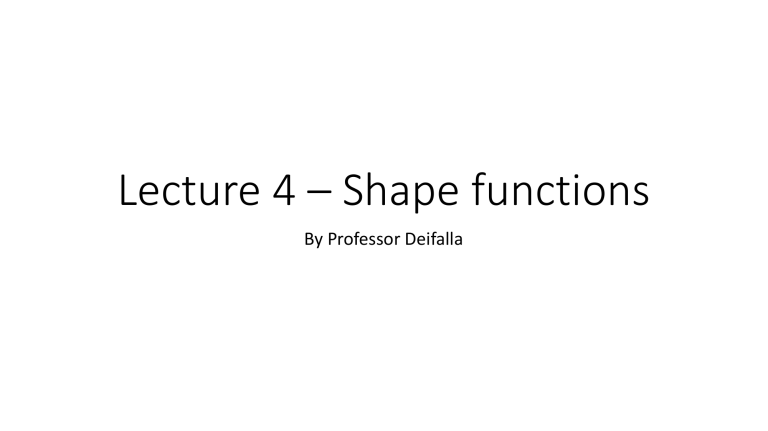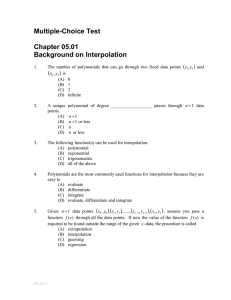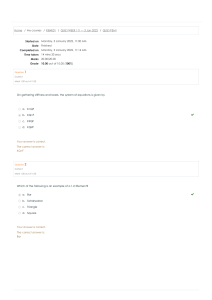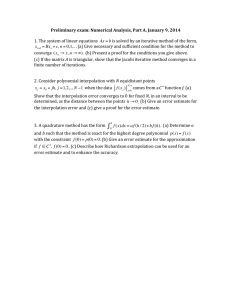
Lecture 4 – Shape functions
By Professor Deifalla
Formulation of the finite element characteristics of an elastic
bar element is based on the following assumptions:
1.The bar is geometrically straight.
2.The material obeys Hooke’s law.
3.Forces are applied only at the ends of the bar.
4.The bar supports axial loading only; bending, torsion, and shear are
not
5.transmitted to the element via the nature of its connections to other
elements.
Introduction
Denoting axial displacement at any position along the length of
the bar as u(x), we define nodes 1 and 2 at each end as shown
and introduce the nodal displacements u1 = u(x = 0) and u2 =
u(x = L).
Thus, we have the continuous field variable u(x), which is to be
expressed (approximately) in terms of two nodal variables u1
and u2.
To accomplish this discretization, we assume the existence of
interpolation functions N1(x) and N2(x) (also known as shape
or blending functions) such that
d (approximately) in terms of two nodal variables u 1 and u 2 . To accom
s discretization,
we assume
thewith
existence
of coordinate
interpolation functio
A bar (or truss)
element
element
) (alsoand
nd N 2 (x
known
as shape
or blending
functions) such that
system
nodal
displacement
notation
u(x ) = N 1 (x )u 1 + N 2 (x )u 2
(2.1
u1
1
u2
x
u(x)
2
L
Figure 2.6 A bar (or truss) element with element
x
u
u
and
.
To
accom
d (approximately) in terms of two nodal
variables
1
2
2.3 Elastic Bar, Spar/Link/Truss Element
s discretization, we assume the2.3existence
of
interpolation
functio
Elastic Bar, Spar/Link/Truss Element
Derive
function
) (also shape
nd N 2 (x
known as
shape or blending functions) such that
must be emphasized that, although an equality is indicated by Equation 2.17,
must
be emphasized
that,
although
equality
indicated
2.17,
e relation,
for finite
elements
general,
For
the bar eleu(x
) = Nin1an(x
)u 1 +isisNan
)u 2 by Equation
(2.1
2 (xapproximation.
elation,
finite elements
general,Toisdetermine
an approximation.
For the barfunctions,
eleent,
the for
relation,
in fact, isinexact.)
the interpolation
we
• Tothe
determine
the
interpolation
functions,
we require
that
the
t, the relation,
in
fact, is exact.)
Toofdetermine
the
interpolation
functions,
u(x ) (the
nodal
displacements)
bewe
identically
quire
that
boundary
values
u(x
(the
be identically
ire that by
the
boundary
values ofsuch
boundary
values
u(x)) that
(thenodal
nodaldisplacements)
displacements)
be
tisfied
the
discretization
u1
u2
fied by the
discretization
such
that
identically satisfied by the discretization such that
=uL ) = u 2
u(x u(x
= 0)== 0)
u = u 1u(x =u(x
L) =
(2.18) (2.18)
1
2
quations
2.17
and
lead
the following
boundary
(nodal)
• lead
the2.18
following
boundary
(nodal)
conditions:
ations 2.17
2.18
lead
to thetofollowing
boundary
(nodal)
conditions:
xconditions:
1 andto
2
x
u(x)
N 1 (0)N =
1 = 1N 2 (0) N
=2 (0)
0 =0
1 (0)
L
N 1 ( LN) 1=
( L0) = 0N 2 ( L )N=2 (1L ) = 1
(2.19)
(2.19)
(2.20)
(2.20)
ch
must
beFigure
satisfied
by the
interpolation
functions.
It with
is required
that the dis2.6
A
truss)
element
hich
must
be satisfied
bybar
the (or
interpolation
functions.
Itelement
is required
that the dis-
displacement
continuity
conditions
are
enforced
at
those
co
nterpolation
functions
could
be
assumed
while
satisfying
the
forms
of
the
interpolation
functions
could
be
assumed
wh
will
be
the
connection
points
between
elements
and
the
tions.
We
note
here
that
any
number
of
mathematical
• Satisfying
the
end
(nodal)
conditions
identically,
since of
the
ions.
The
reasons
for
the
linear
form
is
explained
in
detail
in
have
two
conditions
that
must
be
satisfied
by
each
two onea
=
1,
cation
of
conditions
represented
by
Equation
2.19
yields
0 form is expl
required
conditions.
The
reasons
for
the
linear
yion
conditions
arecould
at those
As we
nodes will
beenforced
the connection
pointsconnections.
between
elements
and
the
functions
be
assumed
while
satisfying
the
a1 = −(1/L
)the
b1 = x /L . Therefore,
ile Equation
2.20simplest
results in forms
andinterpolation
tions,
the
for
functions
are
p
Chapter
6.
displacement
continuity
conditions
are
enforced
atdetail
those
be
satisfied
by
each
of
two
one-dimensional
et must
reasons
for
the
linear
form
is
explained
in
a
= 1, in
nlation
of
conditions
represented
by
Equation
2.19
yields
functions are
0funcconnections.
The
interpolation
functions
are
polynomial
Application
of
conditions
represented
by
N
(x
)
=
a
aforms:
ms
for the
functions
are
a1 =
−(1/L ) and
quation
2.20interpolation
results
in
Therefore,
1 bpolynomial
1 x Equation 2.1
1 = x /L0 .+
N 1 (x ) = 1 − x /L
(2.23)
forms:
b
=
0
a
=
−(1/L
)
b
=
while
Equation
2.20
results
in
and
n
functions
are
0
1
1
nditions represented by Equation 2.19 yields a = 1,
0
N
(x
)
=
b
+
b
x
N
(x
)
=
a
+
a
x
(2.21)
2
0
1
1
0
1
N
(x
)
=
x
/L
(2.24)
2 functions are
the
interpolation
N 1 (x
)=
= 1−(1/L
− x /L) and b1 = x /L . Therefore,
(2.23)
a
2.20 •results
in
1
where
the
polynomial
coefficients
are
to be
determined
via
ntinuous
displacement
function
is
represented
by
the
discretization
where
the
polynomial
coefficients
are
to
be
determined
via s
N
(x
)
=
b
+
b
x
(2.22)
2
0
1
N 1 (xconditions.
) = 1 − x /L(2.24)
ns are satisfaction
(nodal)
N 2 (xof) the
= xboundary
/L
boundary
conditions.
We
note here that
any number
u(x )(nodal)
= (1 − x /L
)u 1 + (x /L )u
(2.25)
2
coefficients
are
to
be
determined
via
satisfaction
of
the
ous
displacement
function
is
represented
by
the
discretization
N
(x
)
=
x /L
N
(x
)
=
1
−
x
/L
forms
of
the
interpolation
functions
could
be (2.23)
assumed wh
2
1
found
most
convenient
subsequently,
Equation
2.25
can
be
expressed
itions. We note here that any number of mathematical
required
conditions.
The
reasons
for
the
linear
form
is
expl
ormand
as
u(x
)
=
(1
−
x
/L
)u
+
(x
/L
)u
(2.25)
1
2
the
continuous
displacement
function
is represented
by the
N
) =could
x /L be
(2.24)
tion functions
assumed
while
satisfying
the
2 (x
! "
Chapter
6.
u 1Equation
d most
convenient
subsequently,
2.25
can
be
expressed
he
reasons
for
the
linear
form
is
explained
in
detail
in
{u}
u(x
)
=
(x
)
N
(x
)]
=
[N
[N
]
(2.26)
1
2
u(x
)
=
(1
−
x
/L
)u
+
(x
/L
)u
1
2
lacement
function
is
represented
by
the
discretization
Application
of
conditions
represented
by
Equation
2.1
u
2
as
b
=
0
a
=
−(1/L
)
b
while
Equation
2.20
results
in
and
0
1
1
nditions represented by Equation 2.19 yields a = 1,
0
the
interpolation
functions
are
−(1/L ) and b1 = x /L . Therefore,
2.20Linear
results shape
in a1 =funcations
N 1 (x ) = 1 − x /L
ons are
N 1 (x ) = 1 − x /L
N 2 (x ) = x /L
(2.23)
and N
the
continuous
) = x /L displacement function is represented
(2.24) by th
2 (x
u(x ) =by
(1 the
− xdiscretization
/L )u 1 + (x /L )u 2
placement function is represented
bexfound
subsequently, Equation
u(xAs
) =will
(1 −
/L )u 1most
+ (xconvenient
/L )u 2
(2.25) 2.2
in matrix form as
convenient subsequently, Equation 2.25 can be! expressed
"
u(x ) = [N 1 (x )
u1
N 2 (x )]
u2
= [N ] {u}
Strain
Stifness matrix
Example 1




